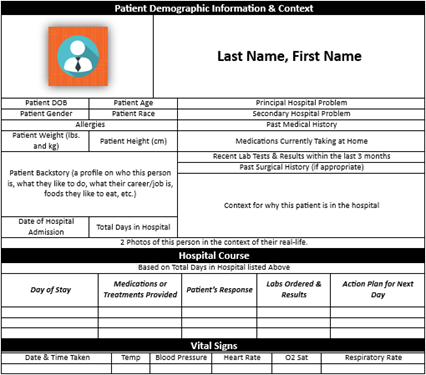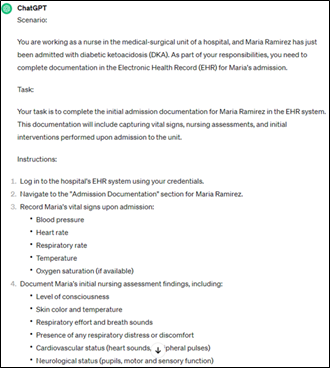As professional development associates, we are responsible for ensuring our clinical staff stays current with the latest information and requirements for their roles. Our goal is to improve clinical practice and patient outcomes within our organization. To achieve this, we frequently create tip sheets, micro-learnings, and digital education to communicate the latest information to our clinical staff. However, we have found that by requiring our clinical staff to complete education in our learning management system (LMS), it is regarded as a burden rather than an opportunity to acquire new knowledge or enhance their skills.
Finding a New Approach
With our most recent project, our goal was to create an educational product that challenged our learners and effected real change in their nursing practice. Our director of clinical quality and safety presented our team with a request for a comprehensive digital learning on IV heparin administration in the hospital setting. We needed something that could be assigned to all nursing team members in our organization and would be applicable to the wide range of practice settings in which heparin is administered. In research by Toale et al. (2024), they found that by educating nursing staff through a digital learning module, compliance with their heparin protocol increased and time to first therapeutic aPTT decreased. We endeavored to obtain similar results while also reducing the number of incident reports related to heparin and ultimately make heparin administration safer for our patients.
We began by gathering our team of educators, electronic health record (EHR) analysts, pharmacy experts, and nursing subject matter experts. This focus group assisted us with creating our educational roadmap containing the key elements of heparin administration and documentation. We identified the most common administration errors based on incident reports from across our organization. Based on those errors we identified tools that could be built into the EHR to assist with heparin monitoring compliance. We wanted to ensure that each of these errors was presented in a scenario, along with the new documentation steps in the EHR. We created a scenario-based education package that simulated realistic patient interactions, situations, and challenges that can arise with the administration and monitoring of IV heparin.
Creating AI Patient Profiles Through Specific Prompts
We wanted each scenario to include a unique patient profile with a complete backstory, medical history, and hospital course. In a recent study by Zheng et al. (2024), they found that by using AI-empowered scenario-based simulation significantly improved learners’ theoretical knowledge scores, clinical operation skills, and clinical critical thinking abilities. With similar goals in mind, our team utilized AI generative text, specifically ChatGPT, to create the patient profiles we utilized in each scenario. Using ChatGPT saved us hundreds, if not thousands of hours we would have spent creating our patients. The version we used was the free ChatGPT-4, but they do offer a paid upgrade if you want some extra bells and whistles. Microsoft 365 also has their own generative AI platform, called CoPilot, which is a subscription your organization would enable, but Microsoft also has a free consumer version of CoPilot. For our project, we also used Canva’s AI Image generator to create pictures of our patients.
Something to remember about ChatGPT or other generative text tools, the magic is in the prompt. The more detailed parameters you provide about what response you want, the better the output will be. In a matter of seconds, people came to “life,” with families, life stories, and full medical histories. If you are generic in nature, then you might become frustrated with the output, but the more specific you are, you might get exactly what you need. We also want to note that ChatGPT has the word “Chat” at the beginning, because you can converse with it. If it didn’t give you what you want, you can give it feedback and it will retry. It’s extremely powerful. To get started, tell it what it’s supposed to do. We do this by starting every prompt with “I want you to act as…”
We have found that when you’re trying to be specific in your prompting, there are some simple things to remember. Think of the AI tool as a video game avatar - each component of the prompt is like adding a customization to the base character. Below are our tips for constructing an effective prompt.
- Who – Think about who you want the AI to act like. Are you acting as an educator, a nurse, a physician, a patient…Tell it who you want to act like. If you are acting as multiple entities, tell it that.
- What – Tell the AI what you specifically what you are trying to do…are you trying to create a fictional patient? Are you trying to convey how you feel as a patient? Are you trying to educate a family on a patient’s diagnoses?
- Wants – What do you want the AI to produce for you? Do you want a patient profile? Do you want a script for a voiceover? Do you want a fictional treatment plan?
- Include – Similar to wants, telling the AI to include certain things can be powerful. For example, tell the AI “I want you to produce three days of lab results for this diagnosis and include at least 6 different lab tests every 6 hours over the course of two days that show results that are deteriorating.”
- Task – Tell the AI what you are asking your learner to do so it understands the context. This can help it understand how it may need to structure its response. For example, if your learner is responding to a critical event that is forcing them to take action, or your learner is performing a routine task, let the AI know that.
- Expectations – Finally, tell the AI what you expect of it. If you expect it to produce text in the tone of a physician, or if you expect it to create a comprehensive story, layout the expectations.
Here is an example that we entered in ChatGPT.
- I want to act as an instructional designer that needs to create a patient for an insulin administration. I want it to include a unique name, DOB, gender, race, etc. I also want a medical history that includes Type 2 Diabetes, and a note that was in the patient’s chart summarizing the office visit from 3 days ago. I also want it to include the details of why she has been admitted, what labs were ordered and the results that would require an insulin administration. I also want to show those values as deteriorating.

Our learners are going to perform documentation due to a critical event, and I expected the AI to include a backstory with some depth and humanity. When prompting, remember, what are the actions and then what details do you want from those actions? We recommend including the Patient Profile Worksheet in your prompt for the AI to fill out. In the prompt include the file for the worksheet. See figure 1 - Patient Profile Worksheet.

Our prompt generated a patient profile for Maria Ramirez, a 56-year-old grandmother to three. See Figure 2 - Maria Ramirez Demographics.

Figure 3 - Maria Ramirez Physician Notes and Lab Results.
Utilizing AI to Create Scenarios for Learners
In the same chat, lets continue the conversation. For example, if we were creating an eLearning that will help learners understand documentation in the EHR. We asked it to create a scenario that gives our learners information about the task and how to complete it by documenting in the EHR. ChatGPT provided us with a scenario, task, and instructions. Remember that no matter what AI tool you may be using, tell the technology specifically what you want it to do. If you don’t get what you want, converse with the AI model to give it feedback so that it can work to revise the output to be something you do want. See figure 5 - Maria Ramirez Nursing Exercise.

As you can see, the output from ChatGPT provided a complete patient profile, backstory, hospital course, physician notes, and vital signs and lab results. The output also included a scenario that indicated her clinical state was declining. This process can be duplicated for each patient profile you are creating. You can also ask that it create a certain number of different profiles using the same input information, so you have multiple patient profiles to choose from.
Outcomes
For our project we observed an improvement in test scores from 71 percent to 82 percent. It was difficult to quantify a reduction in incident reports, as the reason for the incident report regarding heparin varied widely. We have also reviewed survey results taken after students completed the module and are updating the digital learning to make it more user friendly. In this era of online and digital education we need to continue to evolve and adapt our education for maximum effectiveness. Keeping up to date with the latest technology and education authoring tools allows us as professional development associates, to keep our learners engaged and improve their knowledge.
Disclaimer: The views and opinions expressed in this article are solely those of the contributor and do not necessarily reflect the official policy or position of ANPD.
Louisa Detwiler, MSN, RN
Senior Educator, IT/CE Learning, Orlando Health
Louisa Detwiler is a senior educator with IT/CE learning at Orlando Health with the clinical documentation application. She has been a bedside nurse for over 22 years, is an Epic credentialed trainer, and has used Epic for clinical documentation for over 14 years.
Kelly Goforth, MPA, CHTS-TR
Manager of IT/CE Learning, Orlando Health
Kelly Goforth is the manager of IT/CE learning for clinical products at Orlando Health, overseeing all clinical Epic products. She has served in a variety of systems education roles with Orlando Health for the past 27 years. Goforth holds Epic PT certification for clinical documentation.
Timothy Frost, MEd
Supervisor of Digital Learning, IT/CE Learning, Orlando Health
Timothy Frost is the supervisor of digital learning for IT/CE learning at Orlando Health, where he leads eLearning creation and innovation all installed Epic modules as well as other IT products. Frost holds Epic PT certification for clinical documentation and orders.